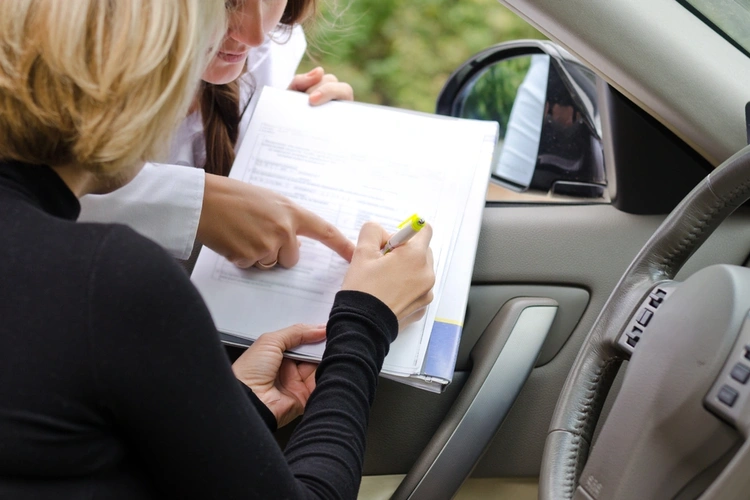No matter whether you’ve decided to sell your car, part-exchange it, or give it to a friend or family member, transferring car ownership isn’t quite as easy as simply handing over the keys. Car ownership is tracked by the government and UK law requires that all changes are logged correctly. It’s not about money changing hands; if someone else is going to be taking over primary responsibility for your car and become its registered keeper. So, you need to let the DVLA know, or you could risk facing a fine.
What’s the difference between the car owner and keeper?
A car’s owner and its registered keeper can often be the same person, but they don’t have to be. Typically, the car owner is the person who initially purchased the vehicle. They could be an individual or a company such as a car finance provider.
In contrast, the registered keeper is the person who’s named on the vehicle’s V5C logbook. While they may not own the car, the registered keeper is legally responsible for its upkeep. It’s also their job to insure and tax the car, make sure it’s roadworthy, and get an annual MOT if it’s three or more years old.
If you get a car on finance, then you will be classed as the registered keeper until the outstanding balance is full paid – at which point you will become the legal owner.
Keep in mind that organisations and individuals can request a registered keeper check from the DVLA if they have reasonable cause, such as needing to issue a parking ticket or identify the keeper of an abandoned vehicle.
What do I need to update on the V5C?
The V5C is one of the most important documents that comes with a car. It’s also known as a logbook and is issued by the DVLA when a vehicle is registered for the first time. Depending on the age of your car, the V5C paperwork might be blue, or if your car was registered after 2012, red. The logbook should be updated each time the car is transferred to a new owner.
You can notify the DVLA by post by completing the detachable V5C/2 slip that you’ll find on your V5C certificate (or logbook) or head online to confirm the transfer. Whichever method you choose, you’ll need the new owner’s name and address.
Once the DVLA has been notified, they will issue a new V5C in the new owner’s name. This process will apply whether you sell the car privately or go to a dealership – the only difference is that you’ll need to complete a different section of the logbook.
What happens if you’ve lost your V5C logbook?
Unfortunately, accidents can happen and your V5C logbook could get damaged, lost, or even stolen. While it is possible to buy and sell a car without a V5C, this isn’t usually recommended, as it could indicate that the car’s been stolen, previously written off, or has outstanding finance.
If you need to replace your V5C, you’ll need to apply for a new one with the DVLA and pay a non-refundable fee of £25. You can request a new logbook online or via the post. You will need to have a few details handy, such as the car’s registration number, its VIN/chassis number, and the name and postcode currently registered to it.
How to transfer car ownership online
The good news is that transferring car ownership can be a surprisingly quick and easy process. Thanks to the DVLA website, you can simply log on to complete a form online to update the details in minutes. To transfer car ownership online, you’ll need the name, address, and email of the new owner as well as the 11-digit reference number listed on your V5C logbook.
Once your request has been received and completed by DVLA, they’ll update the vehicle record and send you and the new owner an email confirmation. A physical copy of the updated V5C should also be sent to the new owner, usually within five working days if the seller registers the vehicle online.
What about car tax?
In the UK, annual car tax is the responsibility of the car’s registered keeper. If you’re buying a car privately or from a dealership, you’ll be liable to pay tax from the date that the DVLA is notified about the change in ownership. The car must be taxed before you drive it (or declared off the road).
If you’ve just sold your car but paid for a year’s car tax upfront, you should automatically receive a refund for any remaining months that now won’t be your responsibility.
How do I transfer car ownership to a family member?
The process to change vehicle ownership remains the same whether you’re selling the car to a stranger or handing it over to a family member for free. It doesn’t matter if they’ve paid you any money or not – if they’re now the car’s registered keeper, then you’ll need to let the DVLA know. Visit the DVLA website to make the transfer or complete the relevant section on the V5C certificate and send it in the post.
How do I transfer car ownership to a dealership?
When you sell or trade in your car for part-exchange at a dealership, you’ll be transferring ownership of the vehicle over to them. And while the process is the same as it would be for selling to a private seller, you will need to complete a different section of the V5C logbook to make the transfer.
Visit the DVLA online to complete the switch or fill in section nine of the V5C and return it in the post. You should also hand the logbook over to the dealership so they can pass it on to the car’s next owner.
Can I transfer car finance to another person?
While it’s relatively straightforward to change vehicle ownership, in the UK you can’t simply transfer an existing car finance agreement to someone else. A car finance loan is a legally binding agreement made between you and the lender and will be tailored to you and your individual circumstances. It’s important to be as upfront and honest as possible when taking out a car finance loan, even if you have a bad credit score or are worried about being rejected. If you commit to a car finance agreement on someone else’s behalf without informing the lender, this is known as ‘fronting’ and is illegal.
If you wish to sell your car before the end of your agreement, you’ll need to become its owner first. This is due to the nature of some car finance loans; with a hire purchase (HP) or personal contract purchase (PCP) deal, the loan is secured against the vehicle, and while you’ll be its registered keeper, the lender will be its owner throughout the loan term.
To avoid knowingly selling a car with outstanding finance (and facing potential legal action) you should either wait until you reach the end of your agreement and take ownership of the car by paying the ‘Option to Purchase’ fee (HP) or balloon payment (PCP), or find out whether you can settle your finance early. Your lender should be able to issue you with a settlement figure at any point during your finance term. This will be the amount you need to pay to end the car finance agreement early.
Once you’re the car’s owner, you’ll be in a position to sell the car if you wish. A prospective new owner can then apply for a finance agreement in their own name to purchase the vehicle.
Get Car Finance up to £100,000
- Check your eligibility without impacting your credit score
- No deposit needed
- Rates from 8.9%* APR
'Representative Example: Borrow £12,000 over 5 years with a £0 deposit. Representative 20.5% APR fixed rate. Monthly payment: £309.93. Option to purchase fee £10 payable. Total cost of credit: £6,605.80. Total amount repayable: £18,605.80.
We are a credit broker, not a lender. We partner with CarFinance 247 Limited, a credit broker (not a lender) who works with a wide panel of lenders.
Disclaimer: We make every effort to ensure content is correct when published. Information on this website doesn't constitute financial advice, and we aren't responsible for the content of any external sites.






